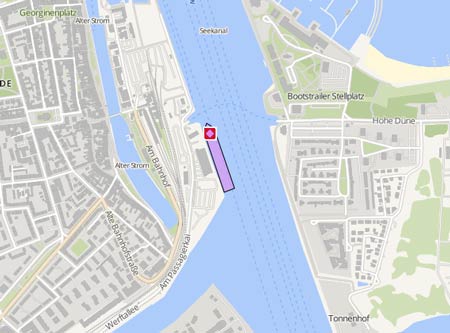MSC RITAverschrottet
Kurs/Position
vor 555 Tagen
Die letzten Häfen
Die letzten Wegpunkte
Die neuesten Nachrichten
Beached
Beached at Alang 23.03.24 as Dead Vessel https://www.facebook.com/photo/?fbid=10160138331460036&set=gm.10162908707793943&idorvanity=6884293942
arrived Alang Anchorage
arrived Alang Anchorage 23.03.23 towed by Tug Thanos II
NTSB report into collision published
The National Transportation Safety Board (NTSB) has released an investigation report on the collision between the 'MSC Rita' and the fishing vessel 'Tremont' (IMO: 7037894) on Oct 28, 2022, about 12.35 a.m. LT 55 miles southeast of Chincoteague, Virginia. The 13 people aboard the 'Tremont' abandoned shoü were rescued by Good Samaritan vessels and a US Coast Guard helicopter. No injuries were reported. An oil sheen was reported; a potential of up to 31,000 gallons of diesel fuel were lost with the fishing vessel. Damage to the vessels was estimated at $4.75 million (Tremont) and $1.5 million (MSC Rita). While the containership was transiting southbound in the Atlantic Ocean, southeast of Chincoteague, the fishing vessel was transiting north-northeast in the same area. Shortly after the 'Tremont' passed ahead of the 'MSC Rita', she suddenly turned back toward the container ship. At that time, the mate on board the 'Tremont' was operating the vessel and attempting to fix the vessel’s gyrocompass, which the captain stated had been off by 10° since 4– 5 days into the trip (investigators were unable to determine what was wrong with the gyrocompass). As he worked to fix the gyrocompass, the mate left the vessel’s autopilot engaged. The 'Tremont'’s autopilot required heading feedback from the vessel’s gyrocompass and a user to input the heading setpoint (desired course). As a result of this heading feedback and user input, the 'Tremont'’s autopilot then output the calculated rudder commands to correct any heading deviation. The amount of rudder used was a function of heading setpoint deviation, the rate of change in the deviation, and the mean deviation. Therefore, as the mate adjusted the gyrocompass to troubleshoot the cause of its error, the autopilot processed the heading feedback, causing the vessel to turn to starboard and toward the 'MSC Rita', striking the container ship on its starboard bow. In the time leading up to the collision, the 'Tremont' mate was standing watch alone in the wheelhouse at night. The vessel was equipped with radar and AIS, which was transmitting but not displaying properly, and the mate was aware of this issue. The vessel’s radar was functioning, and visibility conditions were good (8 miles). The 'MSC Rita' would have presented a substantial radar target, and since the container ship was displaying navigation lights, the mate should have been able to see it visually. However, the Tremont mate told investigators that, while he was on watch, he was preoccupied with troubleshooting the gyrocompass. The mate stated he did not see the MSC Rita on radar nor visually until immediately before the collision. As the 'Tremont' turned back toward the 'MSC Rita', the container ship’s 2nd officer sounded the vessel’s whistle, but the Tremont mate did not hear it. Therefore, the mate’s distraction due to troubleshooting the gyrocompass prevented him from maintaining a proper lookout, and he was thus not aware of the approaching 'MSC Rita'. The ''MSC Rita' bridge team monitored the Tremont crossing ahead and to starboard of the container ship at 12.29 a.m. (about 7 minutes before the collision) when the two vessels were about 2.3 miles apart. The 'Tremont' then unexpectedly turned back sharply toward the 'MSC Rita' a few minutes later. About 12.34 a.m., when the fishing vessel was about 1.3 miles away, the 'MSC Rita' sounded five short blasts of the whistle. However, the 'Tremont' mate did not hear these signals, and the vessel continued on the same heading, closing on the 'MSC Rita'. Although her helmsman switched to hand steering and came hard to port at 12.36:05 a.m. to avoid a collision, there was not enough time to maneuver the container ship out of the path of the 'Tremont', and the fishing vessel struck the 'MSC Rita' about 20 seconds later. The collision resulted in hull damage to the 'Tremont' on its port side and bow. The crew found water in the engine room, a bilge alarm went off in the shaft alley, and within 10 minutes of the collision, flooding was found to have reached the main deck above the fish hold. The crew did not determine the source of the rapid flooding and subsequently abandoned the vessel. Based on witness statements and photographs of the vessel before it sank, the flooding was likely caused by port side shell damage at the engine room and/or the vessel’s forepeak. After the collision, the 'Tremont' captain used VHF to signal distress, but because of the distance between the vessel and the nearest Coast Guard station ashore, the distress call was weak, and Coast Guard watchstanders heard only “MAYDAY” and the vessel’s name. The captain used the vessel’s satellite phone to call 911 and communicate the nature of the emergency, as well as the vessel’s position. The National Transportation Safety Board determined that the probable cause of the collision between the containership and the fishing vessel was the 'Tremont' mate not maintaining a proper lookout and keeping the autopilot engaged while troubleshooting the vessel’s gyrocompass, which resulted in the vessel turning into the path of the 'MSC Rita'.
News schreiben

